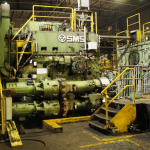
Mathematical modelling, optimization and quality monitoring for side-trimming of heavy steel plates
Project focus
- Analysis and modeling of the side-trimming process of heavy steel plates
- Optimization of the process and the machine design
- Root cause analysis and minization of common quality defects
- Development of a camera- and laser-based quality monitoring system
Description
Side-trimming is an essential process step in the steel industry. The objective of this shearing process is to obtain rectangularly shaped heavy plates after the rolling process. Rolling-cut trimming shears perform this task stepwise and purely mechanically by a rolling-cuts of arc-shaped trimming blades. Due to plate thicknesses up to 45mm, the process forces can reach values of 5MN. Although rolling-cut shearing is the most common method for side-trimming of heavy steel plates, it may entail quality defects like broken edge surfaces, unevenly trimmed edges, or burr. Furthermore, the trimming process might cause a deviation of the plate contour from its ideal rectangular shape.

Principle of rolling-cut shearing for side-trimming of rolled plates.
In this research project, it was found that the lateral process forces acting on the cutting blades have a significant influence on the resulting quality of the trimmed edges. An objective of this project is therefore to obtain a constant lateral process force by optimization of the machine design and the drive kinematics. As a consequence, both quality defects of the trimmed edges and wear of the cutting blades would be reduced.
Another strand of this research project is the development of an automatic quality monitoring system. This system evalutates the quality and the geometric accuracy of each trimmed edge using machine vision and laser-sensor technology. The generated and stored data sets can be used for optimizing the adjustable process parameters and for predictive maintenance of the cutting blades.
Selected publications
- A. Zeiler, A. Steinboeck, A. Kugi, and M. Jochum, Lateral Forces in Rolling-Cut Shearing and Their Consequences on Common Edge Defects, Journal of Manufacturing Science and Engineering, vol. 141, iss. 4, p. 41001-1–41001-9, 2019.
[BibTex] [Download]@Article{Zeiler2019, author = {Zeiler, A. and Steinboeck, A. and Kugi, A. and Jochum, M.}, title = {Lateral Forces in Rolling-Cut Shearing and Their Consequences on Common Edge Defects}, journal = {Journal of Manufacturing Science and Engineering}, year = {2019}, volume = {141}, number = {4}, pages = {41001-1--41001-9}, doi = {10.1115/1.4042578}, } - A. Zeiler, A. Steinboeck, M. Vincze, M. Jochum, and A. Kugi, Vision-based inspection and segmentation of trimmed steel edges, in Proceedings of the 18th IFAC Symposium on Control, Optimization and Automation in Mining, Mineral and Metal Processing, Stellenbosch, South Africa, 2019, p. 165–170.
[BibTex]@InProceedings{Zeiler2019a, author = {Zeiler, A. and Steinboeck, A. and Vincze, M. and Jochum, M. and Kugi, A.}, title = {Vision-based inspection and segmentation of trimmed steel edges}, booktitle = {Proceedings of the 18th IFAC Symposium on Control, Optimization and Automation in Mining, Mineral and Metal Processing}, year = {2019}, month = {8}, pages = {165--170}, doi = {10.1016/j.ifacol.2019.09.182}, address = {Stellenbosch, South Africa}, }
Applications
- Shearing processes
- Automation of rolling mills
- Continuous production processes